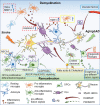Demyelinating processes in aging and stroke in the central nervous system and the prospect of treatment strategy
- PMID: 33210839
- PMCID: PMC7702227
- DOI: 10.1111/cns.13497
Demyelinating processes in aging and stroke in the central nervous system and the prospect of treatment strategy
Abstract
Demyelination occurs in response to brain injury and is observed in many neurodegenerative diseases. Myelin is synthesized from oligodendrocytes in the central nervous system, and oligodendrocyte death-induced demyelination is one of the mechanisms involved in white matter damage after stroke and neurodegeneration. Oligodendrocyte precursor cells (OPCs) exist in the brain of normal adults, and their differentiation into mature oligodendrocytes play a central role in remyelination. Although the differentiation and maturity of OPCs drive endogenous efforts for remyelination, the failure of axons to remyelinate is still the biggest obstacle to brain repair after injury or diseases. In recent years, studies have made attempts to promote remyelination after brain injury and disease, but its cellular or molecular mechanism is not yet fully understood. In this review, we discuss recent studies examining the demyelination process and potential therapeutic strategies for remyelination in aging and stroke. Based on our current understanding of the cellular and molecular mechanisms underlying remyelination, we hypothesize that myelin and oligodendrocytes are viable therapeutic targets to mitigate brain injury and to treat demyelinating-related neurodegeneration diseases.
Keywords: aging; demyelination; remyelination; stroke; white matter injury.
© 2020 The Authors. CNS Neuroscience & Therapeutics published by John Wiley & Sons Ltd.
Conflict of interest statement
The authors declare no conflict of interest.
Figures

Similar articles
-
Matrix metalloproteinases shape the oligodendrocyte (niche) during development and upon demyelination.Neurosci Lett. 2020 Jun 11;729:134980. doi: 10.1016/j.neulet.2020.134980. Epub 2020 Apr 19. Neurosci Lett. 2020. PMID: 32315713 Review.
-
Demyelination and Remyelination: General Principles.Adv Neurobiol. 2025;43:207-255. doi: 10.1007/978-3-031-87919-7_9. Adv Neurobiol. 2025. PMID: 40500500 Review.
-
Loss of Tuberous Sclerosis Complex1 in Adult Oligodendrocyte Progenitor Cells Enhances Axon Remyelination and Increases Myelin Thickness after a Focal Demyelination.J Neurosci. 2017 Aug 2;37(31):7534-7546. doi: 10.1523/JNEUROSCI.3454-16.2017. Epub 2017 Jul 10. J Neurosci. 2017. PMID: 28694334 Free PMC article.
-
A new player in the game: identification of C1ql1 as a novel factor driving OPC differentiation.FEBS J. 2025 Jan;292(1):47-51. doi: 10.1111/febs.17321. Epub 2024 Nov 15. FEBS J. 2025. PMID: 39548653
-
Engineering biomaterial microenvironments to promote myelination in the central nervous system.Brain Res Bull. 2019 Oct;152:159-174. doi: 10.1016/j.brainresbull.2019.07.013. Epub 2019 Jul 12. Brain Res Bull. 2019. PMID: 31306690 Review.
Cited by
-
Leveraging single-cell RNA sequencing to unravel the impact of aging on stroke recovery mechanisms in mice.Proc Natl Acad Sci U S A. 2023 Jun 20;120(25):e2300012120. doi: 10.1073/pnas.2300012120. Epub 2023 Jun 12. Proc Natl Acad Sci U S A. 2023. PMID: 37307473 Free PMC article.
-
Atomic Force Microscope Nanoindentation Analysis of Diffuse Astrocytic Tumor Elasticity: Relation with Tumor Histopathology.Cancers (Basel). 2021 Sep 10;13(18):4539. doi: 10.3390/cancers13184539. Cancers (Basel). 2021. PMID: 34572766 Free PMC article.
-
Early exercise intervention promotes myelin repair in the brains of ischemic rats by inhibiting the MEK/ERK pathway.Transl Neurosci. 2024 Mar 14;15(1):20220335. doi: 10.1515/tnsci-2022-0335. eCollection 2024 Jan 1. Transl Neurosci. 2024. PMID: 38511170 Free PMC article.
-
Contrast-enhanced ultrasound imaging detects anatomical and functional changes in rat cervical spine microvasculature with normal aging.bioRxiv [Preprint]. 2024 Mar 14:2024.03.12.584672. doi: 10.1101/2024.03.12.584672. bioRxiv. 2024. Update in: J Gerontol A Biol Sci Med Sci. 2024 Dec 11;80(1):glae215. doi: 10.1093/gerona/glae215. PMID: 38559128 Free PMC article. Updated. Preprint.
-
Contrast-Enhanced Ultrasound Imaging Detects Anatomical and Functional Changes in Rat Cervical Spine Microvasculature With Normal Aging.J Gerontol A Biol Sci Med Sci. 2024 Dec 11;80(1):glae215. doi: 10.1093/gerona/glae215. J Gerontol A Biol Sci Med Sci. 2024. PMID: 39188137
References
Publication types
MeSH terms
LinkOut - more resources
Full Text Sources
Medical

